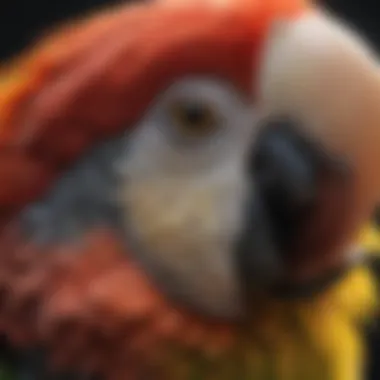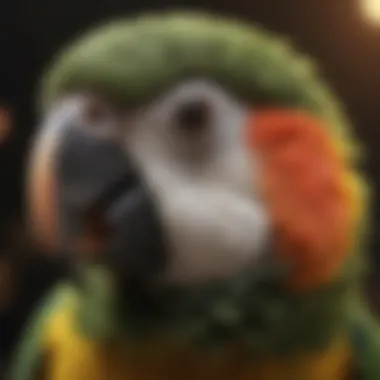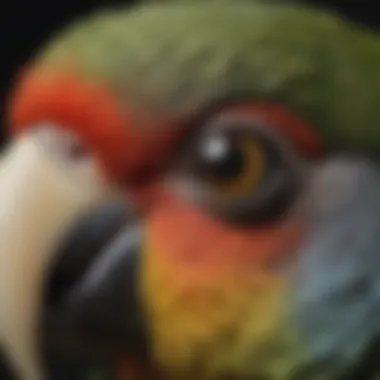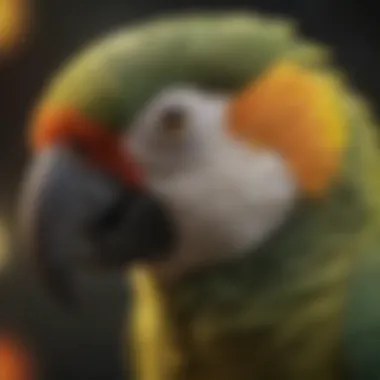Understanding the Parrot Beak: Anatomy and Care Insights


Intro
The parrot beak is more than an attractive feature. It is a complex structure that plays vital roles in the bird's life. Understanding its anatomy and function can greatly enhance the care provided to these intelligent creatures. As a central component of their feeding, communication, and overall health, the beak warrants focused attention from pet bird owners and breeders alike.
Key elements concerning parrot beaks include their adaptations across various species, their intimate relationship with diet and health, and the environmental influences impacting beak condition. Proper inspection and care of the beak can lead to better health outcomes. In this article, we engage with important information surrounding the structure, function, and necessary care practices for your feathered friends.
Care Tips
Taking care of your parrot's beak is an essential responsibility, playing a significant part in their overall well-being. Integrating daily care routines, proper cage setup, hygiene, and seasonal adjustments so that your parrot stays healthy is vital.
Daily Care Routines
Daily routines for your parrot should include a consistent observation of their beak health. Regularly check for signs of overgrowth or abnormalities. A suitable environment allows parrot beaks to naturally wear down through activities like chewing. Provide a secure and conducive atmosphere filled with wooden toys, branches, and other chewable materials.
Cage Setup and Maintenance
An appropriate cage setup significantly affects the health of a parrot's beak. The cage should complement their natural tendencies. Omitting sharp materials from their cage is crucial. Ensure that the cage iron is wrought rather than containing dangerously rigid materials which may injure the smaller birds. This precaution will maintain the natural shape of their beak.
Hygiene and Cleaning Practices
Hygiene is paramount when it relates to beak care. Cleaning food and water dishes daily prevents bacteria buildup that could affect beak condition. Regularly wipe surfaces inside the cage is important. This can help maintain a safe hygiene standard, while also ensure both clean feeding and drinking areas for the paralle.
Seasonal Care Adjustments
As weather changes, parrot care strategies should adapt. Adjusting their care routine during the colder months is significant,especially considering that heat may affect their beak structure. Indoors, using humidifiers may make a difference. Always keep a vigilant eye for signs giving away discomfort and modify care in alignment with observed needs.
Proper care of parrot beaks directly impacts their health and happiness.
Behavioral Insights
Understanding the behavioral patterns of parrots offers insight into their physical health, particularly concerning the beak. Being aware of how they communicate can aid bird owners in recognizing and addressing behavioral issues. Among some common concerns are the pecking, beak maintenance, and interaction with their owners.
Understanding Bird Body Language
Parrot body language is telling. Their posture, wing positions, and even specific beak movements can indicate moods ranging from contentment to stress. Being observant can help narrow down routines that suit individual temperaments.
Common Behavioral Issues and Solutions
Problems may arise if socialization effects are not monitored. Captivity impacts a parrot differently than living in the wild. Each parrot has unique needs, meaning one method does not fit all. Recognizing these potential frustrations is essential and adapting their environment accordingly calms many warning signs.
Positive Reinforcement Techniques
Instead of manually intervening, employing positive reinforcement may pull more effective outcomes during training or handling moments. Using praises and rewards when desired behaviors occur can create trust and improve relationships within bird owner dynamics.
Social Interaction Needs
Parrots, being naturally social beings, require interaction not just with other parrots, but also their human companions. The neglect of social contact could lead to potential rigidity in their behavior over time. Regular, enriched interactions are crucial for stabilizing positive behaviors.
Nutrition Guides
A crucial component of maintaining beak health is ensuring a correct diet. Knowledge about source origin and nutrient concentration affects overall bird health immensely.
Essential Diet Components
Parrots typically need fruits, vegetables, seeds, and grains in their dietary persistence. Fresh produce – such as apples, broccoli, and carrots – should be integrated regularly too due their vitamin potentiation.
Safe and Toxic Foods
Be aware of foods dangerous to birds like avocado, chocolate, and coffee which can be lethal. Maintaining knowledge about safe dietary components also ensures optimal nutrition and supplements their overall health.
Supplements and Treats
Occasional use of treats can support long-term beak care. Supplementing with minerals and vitamins lessens the likelihood of deficiencies. Health boosters specifically designed for parrots can provide additional nutritional value.
Feeding Strategies for Different Species
Species specific does matter. Different parrot types have distinct food preferences and needs. African Grey Parrots may require more nuts suited to their frame, while bigger species like Macaws often need more concentrated seeds and protein types.


Wellness and Health
Indicators of poor health require prompt response from body condition observation to preventive actions. Early symptoms of beak issues can provide critical cues on overall parrot health.
Routine Health Checkups
Periodical consultations with a veterinarian should not be dismissed. Routine checkups aim at preventative actions, catching possible health twists allowing for prompt needs-aware intervention.
Identifying Symptoms of Illness
Be observant of changes levels of energy, eating patterns or weight drops that declare clear signs of overt health dangers; a sick disharmony can regress fairly quickly.
Preventative Care and Vaccinations
Vaccination exercise varies with different subspecies of parrots to reduce widespread endemic illnesses common among captive populations.
Mental and Emotional Well-being
Care extends beyond physical well-being to emotional satisfaction. Fostering patience with the learning processes keeps confident trust in intelligent fowl.
Enriching Activities
Stimulation through consistent activities promotes strong mental health improvements and competes with boredom or undesirable behaviors across their stay within the human families.
Toys and Playtime Ideas
Incorporating enriching toys not only entertains but also exercises beak muscles. Designers have extensively marketed safe toys to withstand chewing desires.
Training and Tricks
Regular training activities bound together with mammal-friendly tricks bolster brain beautifully while fostering interaction.
Outdoor Activities and Interaction
Outdoor appointments can refresh their environments or spatial needs. Supervised interactions in shaded areas allow observational enrichment through new sights and sounds far removed from typical homes.
DIY Projects for Mental Stimulation
Pet owners willingoften invest time creating viable DIY toys that promote engagement from simple starchy ingredients. Even wooden discs can represent helpful products to alleviate a latchable tasks towards stimulation practice.
By integrating a deep understanding of the parrot beak's structure, function, and care methods, owners can support their feathered friends in growing happier and healthier lives.
The Importance of the Parrot Beak
The parrot beak plays a crucial role in the overall health and well-being of these remarkable birds. Its importance extends beyond mere aesthetics; the beak is a multifunctional tool that parrot owners must appreciate. Understanding its structure and function helps in providing better care and support for pet birds. Additionally, focusing on proper beak management can prevent serious health issues in parrots.
Anatomy of the Parrot Beak
Overview of Beak Structure
The structure of a parrot's beak is unique, consisting of three main sections: the upper mandible, the lower mandible, and the keratin outer layer. The upper and lower mandibles articulate in a remarkable manner, allowing birds to perform various tasks. This distinctive anatomy enables strong biting power, essential for cracking seeds and nuts. Such adaptation grants parrots the ability to exploit different food sources efficiently.
An important characteristic is the curvature of the beak, which not only aids in handling food but also provides strength and efficiency for various activities.
Composition of the Beak
The parrot beak is mainly composed of keratin, a protein that also forms hair and nails in other animals. The hardiness of keratin contributes to its durability, helping parrots to tackle tough foods like fruits with hard exteriors. This composition makes the beak an integral part of their feeding strategy. Furthermore, the beak’s coloration can derive from the bird's diet, thus reflecting its health. An inadequate diet may lead to beak deformities and, ultimately, poor health.
Variations Among Species
Beak variations exist significantly among different parrot species, each adapted to specific feeding habits and environments. For example, macaws have long, curved beaks suitable for cracking hard-shell fruits, while lovebirds possess smaller, more delicate beaks for interacting with soft seeds. Recognizing these variations is beneficial for understanding dietary needs and habitat preferences specific to each species. Morphological adaptations also reflect ecological niches occupied by the birds.
Functions of the Beak
Feeding Mechanisms
Feeding mechanisms of parrot beaks are diverse. They are equipped for a range of culinary endeavors that reflect dietary preferences. Parrots use their beaks to grasp, peel, and consume food efficiently. This versatility of feeding methods adapts itself to a wide range of food items, from seeds to fruits. The capability to engage various food sources offers a significant survival advantage in varying ecological contexts.
Communication and Social Interaction


Beyond nutrition, parrot beaks play an important role in communication and social interaction among birds. These beaks are not merely tools for feeding; they are crucial for vocalizations. The interaction between beak and vocal organ produces complex sounds vital for social bonding. Furthermore, parrots may use their beaks as part of non-verbal communication. The gentle nipping can establish social hierarchies or express affection, contributing to a better understanding of parrot behaviors among owners.
Tool Use and Problem Solving
Parrots exhibit extraordinary cognitive abilities, and their beaks facilitate tool use and problem-solving skills as well. Their beaks assist in manipulating various objects to obtain food or play. This ability highlights the functional complexities of the beak beyond its primary purpose of feeding. The intelligence demonstrated through such means underscores the appreciation one must hold for the design and utility of the beak.
Understanding the multiple roles of the parrot beak helps ensure a better grasp of care practices necessary for maintaining a parrot's health and overall vitality.
Types of Parrot Beaks
The study of types of parrot beaks is essential in understanding their adaptation and evolutionary significance. Parrots exhibit diverse beak types, each optimized for specific feeding habits and environmental demands. This section explores the three primary categories: short and stubby, long and curved, and straight and strong beaks. Recognizing these variations helps in providing better care for parrots, ultimately enhancing their health and well-being.
Short and Stubby Beaks
Species Examples
Species such as the Budgerigar or Cockatiel have notable short and stubby beaks. One can observe the striking characteristic of these beaks being compact yet robust. These features enable these birds to efficiently crack open small seeds and nuts. As pet choices, these birds are favored for their less complex dietary needs compared to larger species. Stubby beaks allow them to consume essential nutrients in their diets more easily, making them popular with pet bird owners.
Feeding Adaptations
The feeding adaptations of birds with short and stubby beaks are fascinating. Typically geared towards seed consumption, these adaptations mean that the beaks are strong and well-suited for cracking. The significant advantage here is their ability to process a vast range of soft and hard seeds, broadening their dietary options significantly. However, a limitation exists; such beaks may not be as efficient in accessing soft fruits or larger nuts compared to other beak types.
Long and Curved Beaks
Species Examples
Examples of parrots with long and curved beaks include the Macaw and Eclectus Parrot. These species display pronounced, downturned beaks that are essential for reaching food. Notably, the curvature allows greater leverage to open tough fruits and nuts. Their beauty and vibrant colors make them an appealing choice for many bird enthusiasts, but their specialized beaks can complicate their feeding in a captive environment.
Feeding Adaptations
Long and curved beaks bring unique feeding adaptations. This design enables them to ply deep openings in stationary foods, accessing nutrients from much harder surfaces compared to other beaks. This ability offers a broad range of dietary options, including hard foods. Still, macaws and similar species may struggle to scoop moist or layered foods, which presents certain dietary challenges in captivity.
Straight and Strong Beaks
Species Examples
The Amazon Parrot and African Grey are excellent representatives of birds having straight and strong beaks. Their beaks align more with true strength than flexibility, suited to strong jaws needed for tougher feeding. Such birds are greatly valued for their intelligence and sociability, making them superb companions.
Feeding Adaptations
Straight and strong beaks provide a reliable adaptation for handling dense materials. They can chew through tough seeds, grains, and even some hardwood, reflecting their adaptive strength. An advantage here is the beak's versatility across various food types. While they may not reach fruit as effectively as others, their ability to tackle diverse materials ensures sustained intake of quality nutrition.
Understanding the variable structures of parrot beaks enriches our appreciation for these birds and informs effective caregiving strategies.
Beak Health and Maintenance
Maintaining the health of a parrot's beak is critical for the bird's overall well-being. The beak plays vital roles, such as feeding and grooming, but also is important for social interactions. In this section, we highlight common problems that can affect the health of a parrot's beak and provide strategies to prevent these issues.
Common Beak Problems
Overgrowth and Its Implications
Overgrowth of the beak is a primary concern among bird owners. This condition arises when the beak grows excessively long and becomes misaligned. More often than others, it is linked to inadequate diet or lack of proper wear from chewing activities.
When this occurs, parrots may struggle to eat correctly, leading to weight loss and malnutrition. Another implication is potential damage to the beak itself. A parrot might break or cause pain to their beak from continuous overgrowth. This aspect brings knowledge of Overgrowth and Its Issues to the forefront, indicating the need for careful observation. Regularly check your parrot’s beak and take heed of any signs of odd shapes or lengths.
Bacterial and Fungal Infections
Bacterial and fungal infections can also manifest as serious problems. Patient perspective shows that these infections affect the beak's tissue, often leading to swelling, discharge, and severe discomfort. In more serious cases, the infection relays underlying systemic conditions.
Thus, recognizing timely signs such as flaky skin or unusual color changes in the beak is essential. Prior experience from bird owners has shown that neglect can escalate these problems quickly. Regular cleanings of both the beak and the surrounding area can help limit such infections.
Preventive Care Strategies
Nutritional Needs for Beak Health
Feeding your parrot appropriately nurtures not just the body, but the beak as well. A balanced diet supports strong growth and prevents issues like overgrowth. Foods rich in minerals and vitamins are undeniably piognant essential components. Ingredients such as fresh vegetables, fruits and seed mixtures are useful. Consider less common foods, if hesitance arises such as nuts or healthy grains. Keep consistency in mind; varied diet insures the body receives all needed resources consistently.


Maintaining the right food balance is operational for persuasive physical health in parrots and hence finetunes overall beak health ensuring stability and proper function.
Toys and Chewing Materials
In addition to diet, providing suitable toys and chewing materials adds significant value to your bird’s environment. Engaging beaks on durable fibers and textures allows natural hunting habits to nurture. Items like wooden blocks, ropes, and paper products comply to be beneficial choices, encouraging natural wear and tear of the beak.
Moreover, an array of textures can deter the risk of behavioral issues appearing when parrots feel bored. A well-occupied bird leads to less destructive instincts, thus imposing benefits on the life complexities and health of the parrot's beak structure.
Veterinary Care for Beak Issues
When to Seek Professional Help
Understanding when to falter calls for indulgence in professional guidance is necessary. Observing abnormalities or behaviors that are different can show something might be wrong. If beak issues arise such as drastic misalignment, persistent redness, or swelling, it is prudent to go to a veterinarian. Fitness in veterinary engagements, helps determine diagnosis more accurately than observations alone.
Early examination can ensure time measures, allowing remedy actions before severe damage ensues.
Common Treatments and Procedures
Treatments for beak-related issues depend deeply on the root cause identified by avian specialists. Common interventions may include beak trimming to address overgrowth or administering antifungal medication for infections.
Veterinarians monitor the overall reactions and ensure opt management successfully underpin health, thus promoting normal function in eating and grooming again where trouble descending. Routine examinations will lead to a lengthened ability to maintain functional beaks across their town sphere.
Regular observation paired with optimal preventive care strategies keeps a parrot's beak healthy, ensuring that they live a long and fulfilling life.
Environmental Influences on Beak Development
Environmental factors play a significant role in the development and health of a parrot's beak. Several key influences come into play while ensuring that the beak remains in optimal condition as well as functioning properly. Understanding these factors is important for caregivers, bird owners, and breeders. Fostering the right environment can lead to healthier and robust beasers and contribute to extended lifespans and better quality of life.
Dietary Considerations
Impact of Nutrition on Beak Growth
Nutrition has a profound effect on the growth of a parrot's beak. A correct diet meant for the nutritional requirements ensures normal development. Birds that lack essential vitamins and minerals can face significant beak problems. Without proper nutrients, beaks might exhibit deformations, discoloration, or brittleness. It is essential to include a variety of seeds, nuts, fruits, and vegetables in their diet. This diversifies their intake, making it easy to achieve a slide range of necessary elements that enable good health.
- Lack of vitamins might delay growth.
- Proper calcium intake keeps growth regular and structures whole.
Balanced Diet Essentials
A balanced diet is the foundation of healthy beak development. Owners and breeders must prioritize quality over quantity. Such a balanced diet includes a mix of pellets, seed mixes, whole grains, and fresh produce. When meals are varied, beaks obtain essential nutrition as colors vary within types of foods.
- A well-balanced diet can prevent malnutrition.
- It can improve bonding time between birds and their owners, making feeding enjoyable.
Social Environment Effects
Role of Social Interaction in Development
The social environment also brings a distinct impact on the development of parrots. They thrive in companionship, which significantly boosts emotional and psychological well-being. When parrots interact with other birds, they express themselves more and adapt their beaks through this process. Birds are social creatures and learn by monitoring their peers. Lack of interaction may make species unable to adapt and grow healthily.
- Healthy groups foster more adaptive and stronger beak functionalities.
- Social interactions can reduce anxiety levels in the birds.
Impact of Stress on Beak Health
Stress also plays a detrimental role in influencing beak health. Any stressful impact can hinder proper beak development. Birds under stress may exhibit erratic behavior, which can result to a neglect of self-care. Stress situations stem from several sources, such as sudden environment changes, lack of social interaction, or neglect in diet. Thus, proper management is critical in reducing potential risks to both beak and mental well-being.
- Observing lifestyles and routines helps decrease anxious behaviors.
- Passage of stress is essential because it can be transferred to overall health and temperament.
Ending
Understanding the beak's significance transcends mere aesthetics. In this article, we examined how the beak serves various essential functions and shapes the health and behavior of parrots. The health of the beak directly links to the parrot's overall well-being. Thus, implementing sound maintenance practices is crucial. Knowledge about dietary requirements and environmental conditions enhances capabilities to care appropriately for these birds.
Integrating Knowledge into Bird Care
Tips for Bird Owners
Bird owners can significantly benefit from learning how to maintain their parrot’s beak. Maintaining good beak health not only enhances lifespan but also impacts the bird's quality of life. Adopting techniques such as regularly providing suitable toys can wear down excess beak growth, which is vital for their well-being.
One key characteristic of these tips is that they encourage proactive health care. In addition, choosing specific types of wood or materials for toys influences beak health positively. Toys that allow parrots to chew and gnaw will systematically manage their beak size and strength effectively. Consequently, an educated approach really affects the well-being of pet parents as well, fostering a stronger bond with their feathered companions.
Fostering a Healthy Environment
Creating a healthy environment forms a foundation for a parrot’s overall health. Underlying stress factors can lead to myriad issues including detrimental impact on beak growth. A peaceful and enriching setting encourages proper behavior and supports social interactions; both are critical for maintaining a healthy beak.
Notably, the uniqueness of such environments is how they integrate various stimulating activities that engage parrots. For instance, providing materials for shredding or toys designed for problem-solving can keep parrots happy. This setup contributes favorably to their emotional well-being and minimizes stress. Паая +TRACE enables a smoother process for beak maintenance while positively influencing dietary and social factors.p>
Key Point: Ensuring both beak and emotional health can significantly enhance a parrot's life quality, thereby enriching owners' experiences as caretakers.













